





PHOTO GALLERY

Photos by Len Blumin
1. Common Raven - Corvus Corax
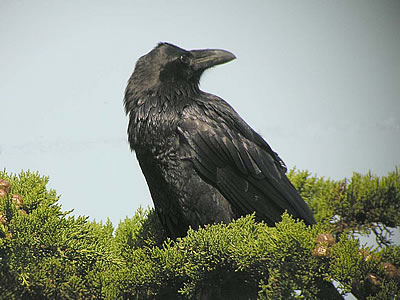
"Is that a Raven or a Crow?"
Birders heard that query often, and sometimes it takes a few moments to respond. If the bird is vocalizing the answer may be straightforward, as the deep hoarse and croaking sounds of the Raven are pretty unmistakable. The Common Raven (Corvus corax) is not really a city bird, so the habitat often gives a clue. Size helps, as the Raven is a rather prodigious "songbird", with a wingspan of 50+ inches and a length of 24" making it about a third again larger than the American Crow, and somewhat larger than the familiar Red-tailed Hawk. The bill can also be a give-away, as the long heavy bill of the Raven is seriously larger than the Crow's, and is a formidable carcass-opening device. The shaggy neck and bumpy head clinch the identification. In flight the "wedge" shape of the tail is different from the uniform fan seen in the Crow. Black birds challenge the photographer, but good light helps. This character was hanging out on a Cypress at the Fish Docks (Chimney Rock), giving Rich Stallcup's group the evil eye. Yes, his head is rotated about 180 degrees as he surveys his territory and casts a baleful eye on the birding group.
2. Gadwall at Gallinas
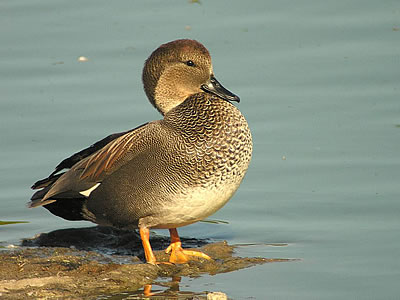
It's mid-October, so we can now look at the ducks without getting totally frustrated. In many birds the winter/basic plumage is rather dull and drab compared to the breeding/alternate plumage that usually appears in the spring and persists through summer. Not so with the ducks, who molt briefly into a dull summer outfit known as eclipse plumage, and then around now begin to don their courting colors, as least the guys do.
Today at Las Gallinas treatment ponds we noted that most of the male ducks were sporting their best duds, including Mallards, Northern Pintails, American Wigeon and Green-winged Teal. The Northern Shovelers are still lagging, but so busy dabbling we couldn't really tell.
And then there is the Gadwall. That's it - one name, and no-one knows where it comes from, as the English have been using this name Gadwall for Anas strepera since the 1600's.
Well, maybe it doesn't deserve a fancy name, since it's just a gray duck with a black butt. That is, until he poses in the right light.
3. Gadwall swimming
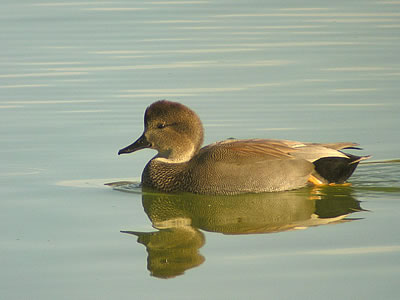
Another shot at Las Gallinas, with the Gadwall drake strutting his stuff. The profile of the head is very distinctive, and usually more puffed up in the back as shown here. We can now barely see the beautiful scaling on the chest and the vermiculations on the flanks. Ya gotta love this guy.
4. Leucistic Horned Grebe
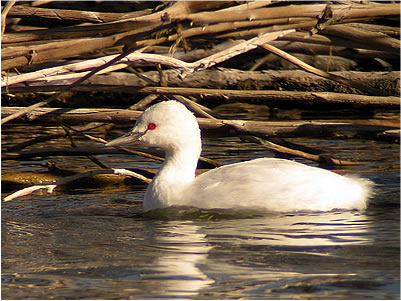
Patti spotted this awesome bird swimming with the Eared Grebes at Mono Lake viewing platform, County Park, at 4pm on October 14 2006. We relocated the bird Oct 14 and 15. Photography was difficult, as the bird was actively feeding and usually not very close. We of course assumed it was an Eared Grebe, mainly by location, but it is a Leucistic Horned Grebe (further reading has made it clear that the use of the word "albino" or "albinism" is inappropriate for birds like this).
5. Can this bird really fly?
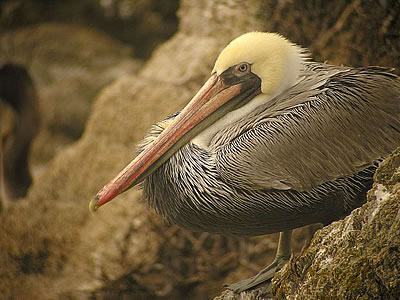
So we're at Bodega Head (Bodega Bay, California) on a "sea watch" with Rich Stallcup. In short that means you look out to sea with binoculars and scope and you can't see a darn thing until Rich teaches where to look and what to look for, and the view gets a whole lot brighter, and becomes filled with a myriad of birds just offshore.
Well, I couldn't capture the Black Scoter that flew by, much less the Jaeger that I missed, but this big fat bird sat on a rock outcropping, seemingly too large to fly anywhere. The Brown Pelican, Pelicanus occidentalis, is now present in good numbers along the west coast, having recovered from being decimated by pesticides in the food chain. What a strange and wondrous creature. Weighing in at 8 pounds or so, heavy for a bird, burdened by huge head and bill, it not only flies with grace and ease, but plunges in a dive for prey in a most spectacular manner, ending in a prodigious splash. Most of the day they seem to spend sitting on rocks or exposed sandbars, so I suspect they are very efficient fisherbirds. Here is full adult, basic plumage.
Taken with Swaro 80 scope, DCA, CoolPix 8400. No cropping, as the bird was too close (100' +) for a full frame shot
6. Downy Woodpecker (Picoides pubescens)
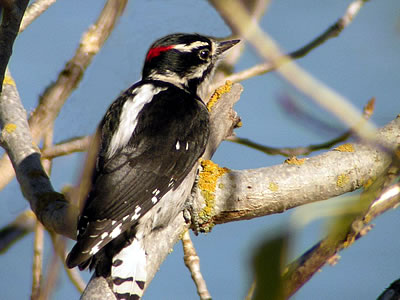
Everybody loves woodpeckers, except maybe for owners of homes on which woodpeckers decide to drill for goodies. The Downy Woodpecker (Picoides pubescens) is American's smallest, measuring less than 7" long and weighing less than an ounce. The Pileated Woodpecker weighs 10 ounces, and even the similar appearing Hairy Woodpecker (Picoides villosus) weighs over 2 ounces.
We saw this one recently in a bare tree along the Las Gallinas treatment ponds. The photo shows most of the important field marks. The white stripe down the middle of the black back pretty much tells you it's either a Downy or Hairy Woodpecker, and the red patch signifies a male. The Downy's bill is smaller than on Hairy, and the white tuft of feathers at the base of the bill is more prominent. These feathers probably protect the nostrils from the sawdust drillings. Looking down along the tree branch we see a single white feather with black bars, very likely an oddly angulated outer tail feather. The Downy's outer tail feathers show black "spots", which in fact are the outer portions of these black bars, whereas in Hairy the outer tail feathers are usually all white. Perhaps this individual is molting some tail feathers, or has lost most of its tail to a hawk, as this is the only tail feather I can see.
- Order: Piciformes (Woodpeckers, Jacamars, Puffbirds, Barbets, Honey-guides, Toucans)
- Family: Picadae, or Picidae - The Woodpeckers, consisting of some 217 species in 26 genera. In the ABA area we have about 22 species in 5 genera. Interestingly, all 5 genera are represented in Marin County, California.
- Genus: Picoides - Large genus, with about 39 species world-wide, and 9 species in the U.S.
- Species: Picoides pubescens - although it looks a lot like the Hairy Woodpecker, the Ency. No. Amer. Birds tells us that the Downy Woodpecker is more closely related to the Ladderback Woodpecker, P. scalaris.
7. Lesser Goldfinch - Carduelis psaltria
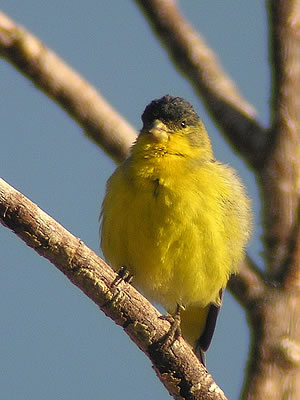
The genus Carduelis includes the Goldfinches, Siskins and Redpolls. The smallest goldfinch is C. psaltria, the Lesser Goldfinch. No, there is no Greater Goldfinch. Go figure. Rich S. sometimes calls them Thistle Finches, as that's where we often see them feeding, and also where they get their Latin name. Carduus = thistle. When the non-native thistles over-run our wildlands we can at least take solace from the idea that the goldfinches will be happy. I know, you are dying to know what "psaltria" means. So was I. Would you believe "a female harp player"? Supposedly for the song of the bird (I'm not buying that part).
We saw many Lesser Goldfinches around Mono Lake in mid-October. As they molt into their winter or "basic" plumage, they lose some of the deep black feathers on back and wings but retain the nice black cap and deep yellow color on the chest. In contrast, the American Goldfinch gets to be a bit drab, the male losing his black cap/forehead and bright yellow chest color.
Here is the male Lesser Goldfinch, taken in late afternoon light at County Park, Mono Lake, October 14, 2006. The warm light makes the yellow glow even more. Distance about 50'.
TOWHEE.NET: Harry Fuller, 820 NW 19th Street, McMinnville, OR 97128
website@towhee.net